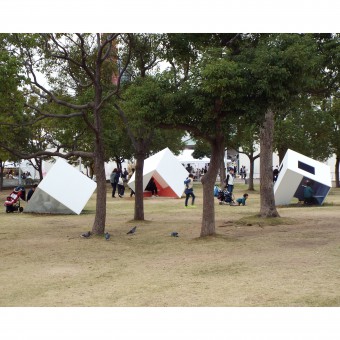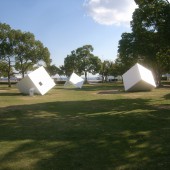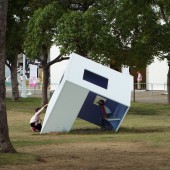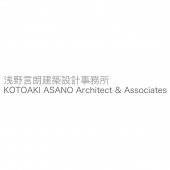Three Cubes in the Forest Movable pavilion by Kotoaki Asano and Makoto Kosuda |
Home > Winners > #56463 |
 |
|
||||
| DESIGN DETAILS | |||||
| DESIGN NAME: Three Cubes in the Forest PRIMARY FUNCTION: Movable pavilion INSPIRATION: Three cubes are referenced to Japanese traditional spaces like tea ceremony rooms. Its characteristics can be explained from the viewpoint of richness, variability, mobility of minimum spaces. Three cubes bring people heuristic spactial experiences and fresh spactial experiences. Three cubes are the device with the various properties and functions, and can be put at the public place. Three cubes can be transport by a truck easily and can be installed, because of the size and the shape. UNIQUE PROPERTIES / PROJECT DESCRIPTION: Playground equipment for children, public furniture, art objects, meditation rooms, arbors, small rest spaces, waiting rooms, chairs with roofs. Three cubes are the device with the various properties and functions. Three cubes can be transported by a truck easily and can be installed, because of the size and the shape, and each place is given the new public extensity. In terms of the size, the installation (the inclination), seat surfaces, windows etc., each cube is designed characteristically. OPERATION / FLOW / INTERACTION: Three cubes can be moved relatively easily, and are the suggestion of the playground equipment with the rich spatial implication. Three cubes have rich spatial characteristics. It can be an art work, public furniture, an arbor, a small rest space. Each cube is designed with much playfulness. Each cube brings a heuristic spatial experience and relaxing time to people. The inside is filled with various devices in comparison with the concise appearance. Urban space is activated by three cubes. PROJECT DURATION AND LOCATION: The project was produced at TAKASAKI/JAPAN in summer of 2015, and was displayed at KOBE Biennale 2015 in autumn of 2015, and is used at NAGANO/JAPAN from 2016. FITS BEST INTO CATEGORY: Architecture, Building and Structure Design |
PRODUCTION / REALIZATION TECHNOLOGY: (a) About size and shape. A part of the cube whose side is 1,800 mm to 2,000 mm is cut off. It is placed so that the cut surface of each cube is on the ground. Therefore, each cube contains space with the richer complexity than imagined. (b) Because of the size and the shape, three cubes are able to be transported by a truck relatively easily (after produced in a factory) and are able to be installed. Three cubes can bring new playful spatiality and public extensity in each place. SPECIFICATIONS / TECHNICAL PROPERTIES: (c) In terms of the degree of leaning, material, a seat surface, a size of window and the placement, each cube is designed characteristically and is distinctively differentiated from each other. For many people, a heuristic spatial experience is possible. (d) The seat and the window are carefully designed in each cube. It is possible for children and families to rest for a long time, and children can meet scenery and people here. Therefore, the dimensional relationships are strictly considered. TAGS: Mobility, Game characteristics, Artistic, Cube, Variability, Arbor, Meditation room, Playground equipment, Resting place RESEARCH ABSTRACT: Three cubes have ambiguous spatial nuances, and it is a device that can be easily transported and allow children to participate in urban space. From the observation at Kobe Biennale 2015, adjustment points were found. In spite of placing abruptly in public places, unspecified number of people flexibly used cubes more than the designer imagined. Also, there is some improvement in the durability of the material. Now, three cubes are installed in the forest at Nagano, and observations are ongoing. CHALLENGE: Three cubes may change the concept of the architecture. Three cubes are furniture, art, small buildings and playground equipment. Therefore, it is located in the border of the conventional design concept. At the same time, while being modern, three cubes trace the traditional spatial concept such as the Japanese old tea-ceremony room. In reality, the problems were the safety for an unspecified number of people to use, the cost for production and the durability of the material, and were solved. ADDED DATE: 2017-03-06 01:31:29 TEAM MEMBERS (3) : Kotoaki Asano / KOTOAKI ASANO Architect & Associates, Toyohito Shibamura / Shibamura Structural Engineers and Makoto Kosuda / Nishizawa Co., Ltd. IMAGE CREDITS: Image #1, Image #2, Image #5 : Kotoaki Asano, 2015. Image #3, Image #4 : Harumi Asano, 2016. Video : Yukio Yoshimura, 2013. Images in PDF : Yukio Yoshimura, Kotoaki Asano, Harumi Asano PATENTS/COPYRIGHTS: Copyrights belong to KOTOAKI ASANO / KOTOAKI ASANO Architect & Associates , 2015. Nishizawa Co., Ltd. , 2015. |
||||
| Visit the following page to learn more: http://bit.ly/2oIVesw | |||||
| AWARD DETAILS | |
 |
Three Cubes in The Forest Movable Pavilion by Kotoaki Asano and Makoto Kosuda is Winner in Architecture, Building and Structure Design Category, 2016 - 2017.· Read the interview with designer Kotoaki Asano and Makoto Kosuda for design Three Cubes in the Forest here.· Press Members: Login or Register to request an exclusive interview with Kotoaki Asano and Makoto Kosuda. · Click here to register inorder to view the profile and other works by Kotoaki Asano and Makoto Kosuda. |
| SOCIAL |
| + Add to Likes / Favorites | Send to My Email | Comment | Testimonials | View Press-Release | Press Kit | Translations |
Did you like Kotoaki Asano and Makoto Kosuda's Architecture Design?
You will most likely enjoy other award winning architecture design as well.
Click here to view more Award Winning Architecture Design.








